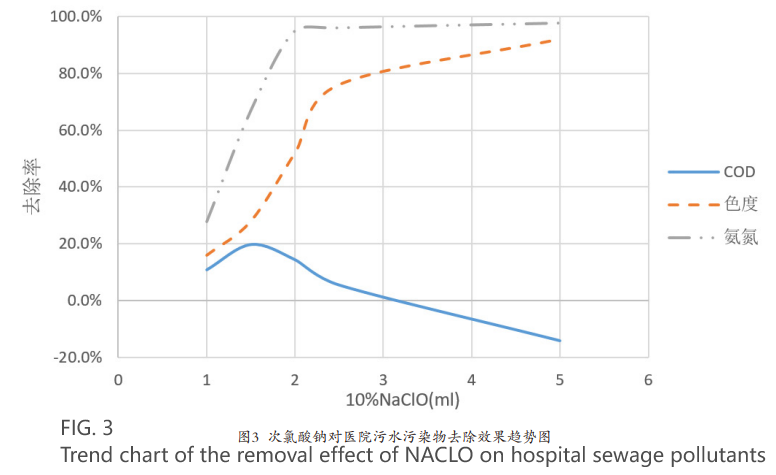Sodium hypochlorite (NaClO) plays an important role in sewage treatment, it is a commonly used disinfectant and oxidant. Sodium hypochlorite molecular formula NaClO, alias bleaching water, slightly yellow solution, unstable properties, strong odor, boiling point 102.2℃, melting point -6℃, soluble in water, relative density (water = 1) 1.10, with oxidation and decolorization, the concentration of sodium hypochlorite solution on the market is generally about 10%. When used for disinfection of hospital sewage, it is non-toxic, no risk in operation and management, and can effectively sterilize; The disadvantage is that organic chlorides (THMs) can be produced by high thermal decomposition, which increases the pH value of the water.
The specific application method of sodium hypochlorite in sewage treatment
Sodium hypochlorite can be disinfected by adding it to sewage, and the common methods include chemical reduction, neutralization and electrolysis. Chemical reduction method reduces sodium hypochlorite to sodium chloride by adding reducing agent such as sodium sulfite, which is simple to operate but needs to strictly control the amount of reducing agent. The neutralization rule reduces the pH value and oxidation of wastewater by adding acidic substances such as sulfuric acid or hydrochloric acid, and is applicable to wastewater with low sodium hypochlorite concentration. Electrolysis is the method used by our company to decompose sodium hypochlorite into chlorine gas and sodium hydroxide by electrolysis, which is a high treatment efficiency but high cost.
Discharge standard for wastewater treated with sodium hypochlorite
Wastewater treated with sodium hypochlorite needs to meet certain discharge standards, which usually require the removal of more than 90% of E. coli and other pathogenic microorganisms. The treated wastewater should ensure that it will not cause harm to the environment and meet the requirements of environmental protection.
The main function of sodium hypochlorite in ordinary sewage treatment
Disinfection: Sodium hypochlorite is an excellent disinfectant, which can effectively kill bacteria, viruses and other microorganisms in sewage. Disinfection is a crucial step in the sewage treatment process to prevent the spread of pathogenic microorganisms and the re-contamination of the environment by sewage. Sodium hypochlorite can quickly and effectively inactivate microorganisms and improve the sanitary safety of sewage.
Oxidation decomposition of organic matter: Sodium hypochlorite also shows good oxidation in sewage, and can react with organic matter to decompose it into harmless substances. This is of great significance for the removal of organic pollutants in sewage, which can reduce the concentration of organic matter in water bodies and improve water quality.
Removal of odor: Sewage is often accompanied by unpleasant odor, which comes from the metabolic products of microorganisms and the decomposition process of organic matter. Sodium hypochlorite can effectively remove the odor in sewage, transform the odor-producing substances into harmless substances through oxidation reaction, improve the odor of sewage and improve the quality of the environment.
Algae removal: In the process of sewage treatment, some algae often grow in sewage, which will not only affect the transparency and perception of the water body, but also may produce toxins and cause harm to the water environment. Sodium hypochlorite can effectively inhibit the growth of algae, thereby reducing the number of algae in the water body and improving the water quality.
Application of bactericidal effect of sodium hypochlorite in hospital sewage treatment
The number of fecal coliform bacteria in water samples was not detected after 1h reaction with 1ml sodium hypochlorite. This is because the concentration of sodium hypochlorite as a disinfectant was too large, far exceeding the dosage recommended by the standard for chlorine-containing disinfectants, so the number of fecal coliform bacteria in water samples was not detected. From the above test data, it can be seen that sodium hypochlorite applied in hospital sewage treatment can not only be used as a disinfectant, but also has a good removal effect on sewage chromatism and ammonia nitrogen, and the removal efficiency analysis is shown in Figure 3.
The experimental data show that adding 1~2ml sodium hypochlorite to 500ml hospital sewage can reduce the concentration of pollutants in effluent and reach the standard of ammonia nitrogen, and the pH of water is still neutral after adding 1~2ml sodium hypochlorite. As can be seen from Figure 3, adding 0.2%~0.4% sodium hypochlorite to hospital sewage can solve the problems faced by hospital sewage treatment while disinfecting, and has a good effect on pollutant removal and is the most economical.
Precautions for treating hospital sewage with sodium hypochlorite
According to the chemical properties, application conditions and purposes of sodium hypochlorite, the following two points should be paid attention to in the practical application of hospital sewage treatment.
First of all, sodium hypochlorite is unstable and can produce organic chlorides (THMs) due to high thermal decomposition, which increases the pH value of water. In actual operation, safety and labor protection measures should be taken, ventilation of dosing room should be strengthened, and automatic dosing control system should be used to avoid manual addition. During the dosing process, pay attention to the pH value of the effluent to avoid excessive pH value; If the effluent is discharged directly into the surface water body, it should be dechlorinated. Secondly, in the case of high or excessive concentrations of color and ammonia nitrogen in hospital sewage, the dosage of sodium chlorate can be referred to. If it is only used for sewage disinfection, it can be added according to the recommended amount of hospital sewage disinfection to avoid waste.
To sum up, adding sodium hypochlorite to hospital sewage can not only disinfect, but also solve the problems existing in hospital sewage, which is an economic and feasible treatment method. In the actual operation of sewage treatment, as long as the operation precautions are strictly observed, the application prospect of sodium hypochlorite in sewage treatment is still very considerable.
The data of the hospital sewage part are from Yu Changliang’s “Minghui”, No. 13, 2021.




